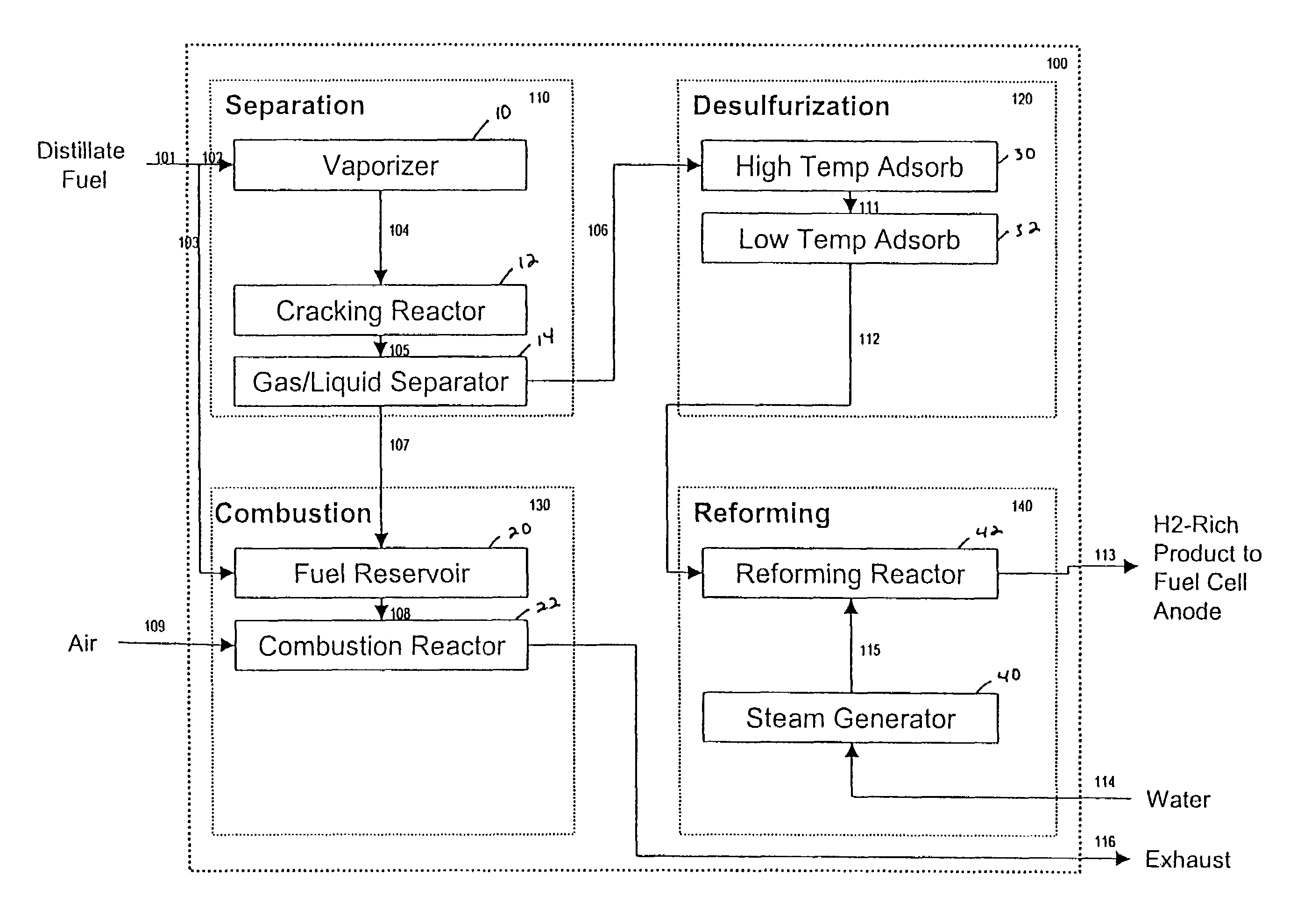Compact distillates fuel processor with effective sulfur removal process
a distillate fuel and process technology, applied in the field of reformers, can solve the problems of difficult storage and transportation, low efficiency, and low efficiency of hydrogen gas, and achieve the effect of high efficiency
- Summary
- Abstract
- Description
- Claims
- Application Information
AI Technical Summary
Benefits of technology
Problems solved by technology
Method used
Image
Examples
first embodiment
[0040]the present invention, a schematic process flow diagram of which is shown in FIG. 1, is an apparatus 100 comprising four distinct assemblies, namely a separation assembly 110, a desulfurization assembly 120, a combustion assembly 130, and a reforming assembly 140. In this embodiment, the separation assembly 110 includes a fuel vaporizer 10, a catalytic cracking reactor 12 and a gas / liquid separator 14.
[0041]A distillate fuel feed stream 101 is split into a vaporizer feed stream 102, and a combustion fuel makeup stream 103. A vaporized and superheated fuel stream 104 is directed from the vaporizer 10 to the catalytic cracking reactor 12 in which the aliphatic content of the fuel is selectively cracked to light hydrocarbon gases while, at the same time, any sulfur present in the fuel as organosulfur species is converted to hydrogen sulfide. The aromatic content of the fuel remains largely unconverted. The catalyst contained in the catalytic cracking reactor 12 is chosen to provi...
fourth embodiment
[0061]the invention, as depicted in FIG. 4, shows a system with water recovery components within the combustion assembly 430 and the reforming assembly 440, such that no water feed stream to the reforming apparatus 400 is necessary. Because water is produced in the combustion reactor component of the combustion assembly 430 and in the fuel cell cathode reaction, the water requirements of the reforming process can be balanced by 68% water recovery in these two water recovery components.
[0062]Two approaches can be applied to achieve this water recovery. One uses condensation by cooling the exhaust stream to near ambient temperature, while the other operates by expanding the humid air to atmospheric pressure in a turbine. In both cases the fuel cell stack will operate at elevated pressure and temperature and a water-air separation is applied. In the turbine application, a compressor can be installed on the turbine shaft, to provide fuel cell stack with pressurized air. The expansion en...
PUM
| Property | Measurement | Unit |
|---|---|---|
| Temperature | aaaaa | aaaaa |
| Percent by mass | aaaaa | aaaaa |
| Percent by mass | aaaaa | aaaaa |
Abstract
Description
Claims
Application Information
 Login to View More
Login to View More - R&D
- Intellectual Property
- Life Sciences
- Materials
- Tech Scout
- Unparalleled Data Quality
- Higher Quality Content
- 60% Fewer Hallucinations
Browse by: Latest US Patents, China's latest patents, Technical Efficacy Thesaurus, Application Domain, Technology Topic, Popular Technical Reports.
© 2025 PatSnap. All rights reserved.Legal|Privacy policy|Modern Slavery Act Transparency Statement|Sitemap|About US| Contact US: help@patsnap.com



